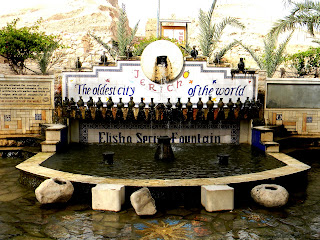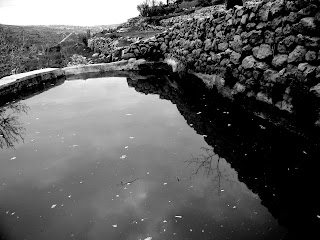Here is another paper. This is from our Jerusalem Approaches Trip. That is pretty much a broad name for all the things we did. It was a great trip. We saw some pretty incredible sites; Mt. of Olives and Bethlehem to name two. I hope you enjoy the paper. As usual Pictures are included!
This week we were able to travel to the areas around Jerusalem. The first place that we stopped was on the eastern side of the Mount of Olives. Right in front of our view was a wall to separate the West bank. However, on the other side of the wall of the left, there was another mountain which is present day El Azariah. In Biblical times it was known as Bethany, the hometown of Lazarus and just 2 miles from Jerusalem. There are tombs from the 1st century AD, showing that there was a settlement during the time of Christ. Just west of Bethany (where we were standing) is the area of Bethphage.
While we were on the mountain top, we turned to map 11-7 in our map book, discussing the last days of the ministry of Christ. In John 11, He raises Lazarus from the dead in order to show the glory of God. He demonstrates that He is the light of the world. At the the end of the day, the question is whether we believe that He is the resurrection and the life. Lazarus was in the tomb for 4 days, he came out with the linens still wrapped around his body. Christ had the power to keep Lazarus from dying, but decided that the best way of demonstrating His power would be to raise him from the dead.
Bethphage is mentioned in Matthew 21, as the Triumphal Entry of Christ. At this time Jesus still had the support of the people at the time of the feast, which was probably the Passover. This would have been the general area where they found the donkey, in order to fulfill the prophecy. He rode the donkey down the Mount of Olives into the temple, this would be Sunday of the Passion Week. On Monday, He goes back to the temple and cleanses it from the idolatry. On Tuesday, He is swarmed with an angry mob: questioning His authority. At this time we looked at Matthew chapter 24-25, dealing with the Olive discourse, talking about the signs that would appear at the end of the age. On Thursday, the upper room was prepared, the last supper took place and Jesus experienced six different trials. Friday at 9 am is when Christ was crucified and Sunday was when He was resurrected. During the whole account Christ was based in Bethany during the passion week.
The Ascension mentioned in Luke 24:50 was on the eastern side of the mount of Olives, it says that He led them toward Bethany, and then lifted up His hands, a cloud covered Him as He ascended into Heaven. We do not know the specific time that He will return, but we know that He will return in the same manner.
We continued to the Paternoster Church, a traditional spot, on the mount of Olives. At this church the Lord's prayer is in about 100 different languages. This example of prayer speaks about the Lord's will and about our daily needs. The Lord does not want us to pray with empty phrases. Prayer is suppose to be a reminder that we need to be dependent on Him. Through the word choice of 'Our Father' there is a demonstration of a relationship, He is our Father and truly wants what is best for us.
As we walked down the mount of Olives, we stopped right above the cemetery. Some of the tombs are 5,000 years old!! From this view there was a good view of the Old city. To the right, we could see the 'tear drop' where Jesus wept over the city of Jerusalem and the “Mary Magdalene” Russian church. As we continued down the mountain, we stopped at Dominus Favi (the tear drop). In Luke 19: 41-44, is where it mentions that Christ wept over the city of Jerusalem. In Matthew 24, it says that no one knows the day or the hour. There could be a time gap and part of the chapter could be discussing the 2nd coming. It was clear though that He was giving warning about false prophets, a sign does not mean that they are of Christ. We have to continuously be on the watch and ready for the return of the Lord.
Garden of Gethsemane, this is the traditional place from the Byzantine period. It means oil press. He brought Peter, James, and John, it was a place known to the disciples and the account is in John 18:1. The
Church of the Nations is built on this site. Just outside of Gethsemane was a cave, where tradition says that this is where the disciples slept. The cave was used to make oil form the olive press. There is a possibility that from the 2nd Century AD, there is a connection to the garden in some sort of way. In Mark 14, it discusses how there was a man that had a linen cloth around his naked body, and followed Christ after he was arrested. This could possibly show that they were planning on staying the night there. Also on this site is a church, which is suppose to hold the tomb of Mary.
Before we arrived in Bethlehem, we stopped at the 'shoulder of the Hinnon valley' Ketef Hinnon. There are tombs, that encircle the city of Jerusalem, like a belt. However, at this spot Edward Robinson discovered tombs from the Old Testament period, from 8th BC. In most cases tombs are robed, but in 1979 there was a discovery because the roof had collapsed blocking the entrance. Inside this old tomb, they discovered silver amulets, which took 2 years to unroll. They were 2in x ? in. It was an interesting find because LORD was the first word in the inscription of a priestly prayer from Numbers 6. It dates back to the late 7th century 610 BC, a good 400 years older than the dead sea scrolls! They are able to use pottery that was discovered and the shape of the letters to see what time period they are from.
In Judges 17-18, we are able to see a connection to Bethlehem. This passage is used to show how depraved the nation had become set up narrative for David, who is from Bethlehem. In Micah 5:1, the prophecy decrees that the Messiah will be born in Bethlehem. God has the ability to use circumstances for His good. In Bethlehem there is the church of the Nativity, built by Helena, Constantine's mother. Tradition says that it was built over caves, there also seems to be evidence of a 1st century settlement. As we left Bethlehem, we were able to see some fields, that could have possibly been where the angels appeared to the shepherds.
Final stop was Herodian, a palace built by Herod the Great, in the middle of the Judean Desert, as a winter get away. This is where Herod was buried and just two years ago a sarcophagus was found. He built walls and then packed dirt, had the walls connect to 4 towers, and then there are two walls, where there would be a passage way for servants. The palace was divided in 2 sections on the east there was a covered walkway with vegetation and on the west there were dwelling place and a bathhouse. Herod the Great was considered a half-Jew, so when the Magi came in Matthew 2, they were looking for the one that was Born King of the Jews, Herod was Made King of the Jews. His life ended insickness and a painful death.

That is the West Bank Wall and just beyond it is Bethany
I nice looking flower
A few of the Languages that the Lord's prayer were written in
Christina and friends in front of the hebrew one
Old City and Temple Mount from the MT. Of Olives
Random Camel= pretty sweet
Random guy and Camel= much sweeter
Closest thing we have seen to in and out
In front of the church at the Garden of Gethsemenee
Garden of Gethsemenee
Same Church in the garden
Place where the silver scrolls were found that date to 610 B.C.
Closest thing to Starbucks we have seen. Even looks like it. In Bethlehem. Jesus and Coffee?
Herod's private mountain he built
Inside the mountain. His Palace
On top of the mountain with a great view of the Judean Wilderness
Part of the building
Ben and Christina From Israel!

















































